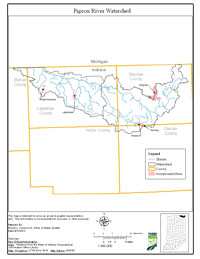Location
The Pigeon River watershed is located in northern Indiana, draining approximately 396 square miles in Steuben, Lagrange, DeKalb, Elkhart, and Noble Counties. Major streams included in the TMDL report are Pigeon River and tributaries to Pigeon River.
History
A comprehensive survey of the Pigeon River watershed was conducted by Indiana Department of Environmental Management (IDEM) in 2010. The primary cause of impairment is Escherichia coli bacteria (E. coli) and Nutrients. Pollution sources in the watershed include non-point sources e.g. row crop agriculture and pastures, urban and rural runoff, land application of manure, and point sources e.g. straight pipe dischargers, home sewage treatment system disposal, and combined sewer overflow outlets.
Pollutants Addressed
TMDLs for the Pigeon River watershed are established for Escherichia coli bacteria (E. coli) and Impaired Biotic Community (IBC) and will address 50 impairments (49 E. coli, and 1 Nutrient/IBC). Some of the recommended solutions to address the impairments include storm water controls, point source controls, manure management, and habitat improvements.
Timeline
Two Kickoff TMDL Meetings were held on April 6, 2011. The first meeting was held at the LaGrange County Annex, 114 W. Michigan St, LaGrange, IN. The second meeting was held at the Steuben Count Community Center, 317 S. Wayne Street, Angola, IN.
Two Draft TMDL Meetings are scheduled on May 23, 2012. The first meeting will be held at the LaGrange County Annex, 114 W. Michigan St, LaGrange, IN. The second meeting will be held at the Steuben Count Community Center, 317 S. Wayne Street, Angola, IN.
The 30-day public comment period will be May 23, 2012 through June 23, 2012.
U.S. EPA under Section 303(d) of the Clean Water Act has yet to approve the Pigeon River Watershed Total Maximum Daily Load (TMDL) report. TMDL reports identify and evaluate water quality problems in impaired water bodies and propose solutions to bring those waters into attainment with water quality standards.

